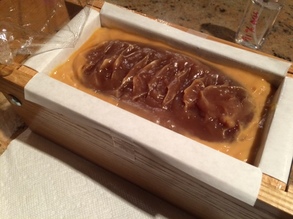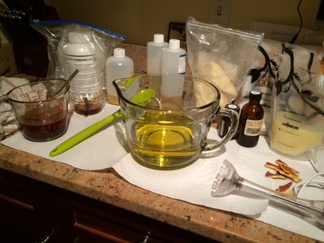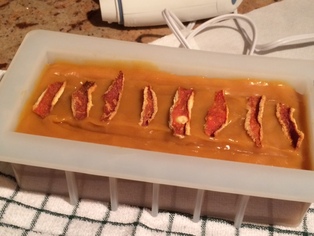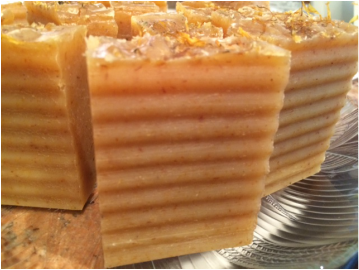|
For quite some time now, I've been so anxious to get into the art of Cold Process soap so that I can offer my customers a true "from scratch, nothing but natural" soap line. So I've spent many a month doing research on what various oils have to offer the skin, which ones make a healthy lather, which ones might clean "too" well and dry out the skin, which ones make a hard bar and which are too soft, what ratios of each oil are needed to make a healthy lather that cleans but doesn't dry that smells yummy but it hard enough to last in the shower...whew! And my head was spinning! But now that I've read and researched, and spent time playing in the kitchen, I'm finally happy with a recipe I've tweaked as my base soap. Once I decided on my base, I was able to get some creative fun going by using different liquids to see what might be the result. Even though my base oils are the basically the same, using different liquids can totally change the outcome, smell, and feel. Some of the liquids I've been playing with are strong chamomile tea, organic lemon tea, flat amber ale, Guiness stout ale, fresh-brewed coffee, apple cider, and wine. All these liquids actually do have skin-loving properties and each one makes its own special type of soap. So just what is "real" SOAP?
Each oil has a saponification value or SAP that tells how much lye is needed to turn all of that oil into soap. Each oil can be a different value, so careful calculation is needed to make sure enough lye is used but not too much to have any left over...or you might just have irritated skin! I always calculate my ratio to include about 5% extra oils that won't be saponified so that they are left to add moisture and skin-conditioning qualities to the soap. An after-product of making soap is glycerin which I leave in my soap to add skin-softening and moisture-drawing attributes in each bar. Essential oils are added for scent and skin-loving properties, as well as, herbs, coffee grounds, and other additivies to enhance the finished soap. Sometimes I'll add a fragrance oil to enhance the scent of the soap since some scents just don't exist in an essential oil. Once the soap is taken out of the mold and sliced, it needs to air dry for 4-6 weeks before using. This cure time allows all the lye to react with the oils so that nothing but clean, nourishing soap is left! Below you'll see some examples of the different soaps currently curing and how each one looks different from the others. Plans are already in the works to expand the line to include milk soaps using goats milk, coconut milk, yogurt, heavy cream...just about any type of "milk". Cleopatra swore by milk soap knowing how beautiful it can help keep your skin! So stay tuned!
4 Comments
1/31/2023 11:01:20 am
Excellent article! Thank you for your excellent post, and I look forward to the next one. If you're seeking for discount codes and offers, go to couponplusdeals.com.
Reply
Leave a Reply. |
Welcome to Tailored Tidbits!If I'm not in the kitchen cooking up new items for my shop, I'm sewing fabric baskets, taking care of our honeybees, pitching in on the latest project at my son's, or planning a trip somewhere with my daughter. Here, I'll share a "day in the life" at Tailored Touches! 
Sign up for the newsletter for an instant 10% off coupon.
Categories
All
Archives
February 2019
|










 RSS Feed
RSS Feed


